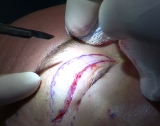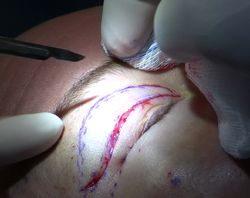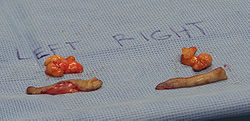
Blepharoplasty
Encyclopedia

Surgery
Surgery is an ancient medical specialty that uses operative manual and instrumental techniques on a patient to investigate and/or treat a pathological condition such as disease or injury, or to help improve bodily function or appearance.An act of performing surgery may be called a surgical...
modification of the eyelid
Eyelid
An eyelid is a thin fold of skin that covers and protects an eye. With the exception of the prepuce and the labia minora, it has the thinnest skin of the whole body. The levator palpebrae superioris muscle retracts the eyelid to "open" the eye. This can be either voluntarily or involuntarily...
. Excess tissue such as skin
Skin
-Dermis:The dermis is the layer of skin beneath the epidermis that consists of connective tissue and cushions the body from stress and strain. The dermis is tightly connected to the epidermis by a basement membrane. It also harbors many Mechanoreceptors that provide the sense of touch and heat...
and fat
Adipose tissue
In histology, adipose tissue or body fat or fat depot or just fat is loose connective tissue composed of adipocytes. It is technically composed of roughly only 80% fat; fat in its solitary state exists in the liver and muscles. Adipose tissue is derived from lipoblasts...
are removed or repositioned, and surrounding muscle
Muscle
Muscle is a contractile tissue of animals and is derived from the mesodermal layer of embryonic germ cells. Muscle cells contain contractile filaments that move past each other and change the size of the cell. They are classified as skeletal, cardiac, or smooth muscles. Their function is to...
s and tendon
Tendon
A tendon is a tough band of fibrous connective tissue that usually connects muscle to bone and is capable of withstanding tension. Tendons are similar to ligaments and fasciae as they are all made of collagen except that ligaments join one bone to another bone, and fasciae connect muscles to other...
s may be reinforced. It can be both a functional and cosmetic surgery.
Indications
Blepharoplasty is often done as an elective surgeryElective surgery
Elective surgery is surgery that is scheduled in advance because it does not involve a medical emergency...
for cosmetic reasons. Lower eyelid blepharoplasty is almost always done for cosmetic reasons, to improve puffy lower eyelid "bags" and reduce the wrinkling of skin. Asian blepharoplasty
Asian blepharoplasty
Asian blepharoplasty, also known as "double eyelid surgery", is a type of cosmetic surgery where the skin around the eye is reshaped . The purpose of the procedure is to create an upper eyelid with a crease from an eyelid that is naturally without a crease...
or double eyelid surgery is a special type of blepharoplasty that creates a crease in the upper eyelid. This "supratarsal fold" is common in many races but absent in about half of Asians. Surgery can artificially create this crease and make a 'single-lidded' patient appear 'double-lidded'. It is the most popular form of cosmetic surgery among those of east and southeast Asian background.
Blepharoplasty is sometimes needed for functional reasons. When an advanced amount of upper eyelid skin is present, the skin may protrude over the eyelashes and causes a loss of peripheral vision
Peripheral vision
Peripheral vision is a part of vision that occurs outside the very center of gaze. There is a broad set of non-central points in the field of view that is included in the notion of peripheral vision...
. The outer and upper parts of the visual field are most commonly affected and the condition may cause difficulty with activities such as driving or reading. In this circumstance, upper eyelid blepharoplasty is performed to improve peripheral vision.
Procedure

Eyelash
An eyelash or simply lash is one of the hairs that grow at the edge of the eyelid. Eyelashes protect the eye from debris and perform some of the same function as whiskers do on a cat or a mouse in the sense that they are sensitive to being touched, thus providing a warning that an object is near...
of the lower lids. Incisions may be made from the inside surface
Conjunctiva
The conjunctiva covers the sclera and lines the inside of the eyelids. It is composed of rare stratified columnar epithelium.-Function:...
of the lower eyelid (transconjunctival blepharoplasty); this allows removal of lower eyelid fat without an externally-visible scar, but does not allow excess skin to be removed. External skin resurfacing with a chemical peel or carbon dioxide laser may be performed simultaneously. This allows for a faster recovery process.
The operation typically takes one to three hours to complete. Initial swelling and bruising resolve in one to two weeks but at least several months are needed until the final result becomes stable. Blepharoplasty's effects are best appreciated by comparing before and after photos of surgical patients.
The anatomy of the eyelids, skin quality, age, and the adjacent tissue all affect the cosmetic and functional outcomes. Factors which are known to cause complications include:
- dry eyes - which may become exacerbated by disrupting the natural tear film
- laxity (looseness) of the lower lid margin (edge) - which predisposes to lower lid malposition
- prominence of the eye in relation to the malar (cheek) complex - which predisposes to lower lid malposition
Recovery
The recovery process after a blepharoplasty may take up to a few weeks. Patients will receive instruction for during the home careHome care
Home Care, , is health care or supportive care provided in the patient's home by healthcare professionals Home Care, (also referred to as domiciliary care or social care), is health care or supportive care provided in the patient's home by healthcare professionals Home Care, (also referred to as...
and most of the time they receive painkillers that ease the pain caused by the incisions.
The first two days after the operation has been performed, the patient receives an ointment treatment to keep the incisions lubricated. Doctors recommend keeping iced eye pads on the eyes to reduce bruising and swelling
Swelling (medical)
In medical parlance, swelling is the transient enlargement or protuberance in the body and may include tumors. According to cause, it may be congenital, traumatic, inflammatory, neoplastic or miscellaneous....
. Eye drops
Eye Drops
Eye Drops was a television program on TechTV that showcased short computer animation movies and clips made using off the shelf 3D animation software. The show claimed to showcase all different types of animation, but only a very small number of shorts featured non-CG animation...
may also be prescribed as they may help in pain management and in preventing infections. Patients are recommended to keep their heads higher than the body while sleeping as this will accelerate the recovery process.
Different medications can help in moderating bruises and swelling resulted after surgery and also to accelerate the patient's recovery
Healing
Physiological healing is the restoration of damaged living tissue, organs and biological system to normal function. It is the process by which the cells in the body regenerate and repair to reduce the size of a damaged or necrotic area....
. One of them is Wobenzym
Wobenzym
Wobenzym is an enzyme tablet containing plant-based enzymes bromelain and papain, allegedly to support a healthy immune system. These statements have not been evaluated by the Food and Drug Administration. This product is not intended to diagnose, treat, cure, or prevent any disease...
, an agent that helps in moderating swelling. Wobenzym should be administrated the second or third days after surgery and three times a day. The patient's condition will improve without this medication as well as it is only an additional treatment. Auriderm is another medication that has quite a similar effect as Wobenzym. Auriderm must be applied 10 days before the blepharoplasty and twice a day. There are however many products like these that could accelerate one's recovery and they must be discussed with one's surgeon.
The third day after surgery, the patients are advised to keep lukewarm eye pads for comfort and wearing dark glasses for at least one week is also recommended to prevent irritation
Irritation
Irritation or exacerbation, in biology and physiology, is a state of inflammation or painful reaction to allergy or cell-lining damage. A stimulus or agent which induces the state of irritation is an irritant...
that may be caused by the wind and sun exposure.
The stitches are usually removed two days after the operation. The patient's eyelids will be discolored and swollen for about seven to ten days, and feel "tight" or "stiff" for a while. Patients should lubricate their eyes by exercising closing their eyes or looking at the ceiling.
During the first few weeks after a blepharoplasty, patients normally experience excessive tearing, light sensitivity and sometimes double or even blurred vision
Blurred vision
-Causes:There are many causes of blurred vision:* Use of atropine or other anticholinergics* Presbyopia -- Difficulty focusing on objects that are close. The elderly are common victims....
. The whites of the patient's eyes can turn red or have red splotches. These symptoms usually disappear on themselves within two or three weeks after the operation.
Wearing contact lenses is prohibited until the incisions are completely cured. Patients who need them will be advised by their doctor when it is safe to wear them again.
Patients who undergo a blepharoplasty may watch TV and are able to read after two or three days after surgery. Patients may go to work in a week or ten days after the operation. The scar
Scar
Scars are areas of fibrous tissue that replace normal skin after injury. A scar results from the biological process of wound repair in the skin and other tissues of the body. Thus, scarring is a natural part of the healing process. With the exception of very minor lesions, every wound results in...
s may however still be visible, but one can use makeup to cover them.
As a part of blepharoplasty recovery, the patient must avoid bending at the waist
Waist
The waist is the part of the abdomen between the rib cage and hips. On proportionate people, the waist is the narrowest part of the torso....
for about five days and strenuous activity (especially activities that raise one's blood pressure
Blood pressure
Blood pressure is the pressure exerted by circulating blood upon the walls of blood vessels, and is one of the principal vital signs. When used without further specification, "blood pressure" usually refers to the arterial pressure of the systemic circulation. During each heartbeat, BP varies...
, such as lifting and rigorous sports) for about ten days to two or three weeks.
Surgery will leave scars, but they are usually well hidden and normally fade in time.
Blepharoplasty may leave patients with bruises or swelling on their faces, and sometimes patients become depressed because of this. These are some of the side effects of surgery, which are completely normal and which disappear in few weeks, after a complete healing
Healing
Physiological healing is the restoration of damaged living tissue, organs and biological system to normal function. It is the process by which the cells in the body regenerate and repair to reduce the size of a damaged or necrotic area....
.
History
Karl Ferdinand von GräfeKarl Ferdinand von Gräfe
Karl Ferdinand von Graefe was a German surgeon from Warsaw. He was also the father of Albrecht von Graefe and grandfather of Albrecht von Graefe....
coined the phrase blepharoplasty in 1818 when the technique was used for repairing deformities caused by cancer in the eyelids.
The roots of the present cosmetic advancements began around 3000 years ago with the ancient Egyptians. Documents “written on papyrus text detail how surgeons, even in that primitive age performed reconstructions on lips, noses, and ears using skin grafts cut from folds from the forehead or cheek.” As techniques began developing the ancient Greeks and Romans began writing down and collecting everything they knew involving these procedures. Aulus Cornelius Celsus
Aulus Cornelius Celsus
Aulus Cornelius Celsus was a Roman encyclopedist, known for his extant medical work, De Medicina, which is believed to be the only surviving section of a much larger encyclopedia. The De Medicina is a primary source on diet, pharmacy, surgery and related fields, and it is one of the best sources...
, a first century Roman, described making an excision in the skin to relax the eyelids in his book De Medicine. Knowledge of blood circulation and tissue health were discovered and spread throughout the ancient world allowing techniques to improve. However, during the Middle Ages, plastic surgery was prohibited because it was viewed as something that was spiritually unethical. This ban was also due to poor hygiene. During the Renaissance, intellectuals rediscovered texts from ancient Greece and Rome illustrating surgical procedures and techniques.

World War II
World War II, or the Second World War , was a global conflict lasting from 1939 to 1945, involving most of the world's nations—including all of the great powers—eventually forming two opposing military alliances: the Allies and the Axis...
and other subsequent catastrophes. As with any medical advancements, the development of surgical techniques goes through a period of trial and error as reconstructive surgery did during World War I. Each improvement eventually becomes the root of future advancements allowing physicians to combine procedures such as a basic lid fat resection and chemical peels ensuring a speedy recovery.
Non-surgical alternatives
Non-surgical alternatives have shown improvement with patients exhibiting early indications of facial aging. Lasers, chemical peels, botulinum toxin, and dermal fillers are all used in some degree to treat periorbital tissue. Although effective, these treatments are not technically "blepharoplasty" and yet some practitioners refer to any treatment involving the eyes as such; often preceded by "laser", "non-surgical" or "lunch-time". Botulinum toxin, it should be noted, is used to relax the muscles in the forehead and between the eyes, therefore not addressing most of the issues a patient seeking a blepharoplasty would want fixed.In so–called "non-surgical blepharoplasty" topical applications of acids and/or the use of lasers are used to tighten and decrease skin volume in the upper and lower eyelids. Injectable dermal fillers are also used to temporarily increase volume in the trough area between the lower eyelid and the cheek. These techniques are effective yet have not replaced surgical treatments, and should not be confused with blepharoplasty, which treats not only the superficial skin tissue, but also underlying connective and muscle tissues.
See also
- Eye surgeryEye surgeryEye surgery, also known as orogolomistician surgery or ocular surgery, is surgery performed on the eye or its adnexa, typically by an ophthalmologist.-Preparation and precautions:...
- OculoplasticsOculoplasticsOculoplastics, or oculoplastic surgery, includes a wide variety of surgical procedures that deal with the orbit , eyelids, tear ducts, and the face...
- Cosmetic surgery
- Plastic surgeryPlastic surgeryPlastic surgery is a medical specialty concerned with the correction or restoration of form and function. Though cosmetic or aesthetic surgery is the best-known kind of plastic surgery, most plastic surgery is not cosmetic: plastic surgery includes many types of reconstructive surgery, hand...
- Maxillofacial surgery
- Asian blepharoplastyAsian blepharoplastyAsian blepharoplasty, also known as "double eyelid surgery", is a type of cosmetic surgery where the skin around the eye is reshaped . The purpose of the procedure is to create an upper eyelid with a crease from an eyelid that is naturally without a crease...

